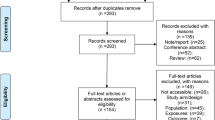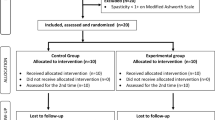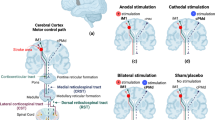Abstract
Objective
This study aimed at investigating the effect of a single-session repetitive transcranial magnetic stimulation (rTMS) of the contralesional dorsal premotor cortex on poststroke upper-limb spasticity.
Material and methods
The study consisted of the following three independent parallel arms: inhibitory rTMS (n = 12), excitatory rTMS (n = 12), and sham stimulation (n = 13). The primary and secondary outcome measures were the Modified Ashworth Scale (MAS) and F/M amplitude ratio, respectively. A clinically meaningful difference was defined as a reduction in at least one MAS score.
Results
There was a statistically significant change in MAS score within only the excitatory rTMS group over time [median (interquartile range) of − 1.0 (− 1.0 to − 0.5), p = 0.004]. However, groups were comparable in terms of median changes in MAS scores (p > 0.05). The proportions of patients achieving at least one MAS score reduction (9/12 in the excitatory rTMS group, 5/12 in the inhibitory rTMS group, and 5/13 in the control group) were also comparable (p = 0.135). For the F/M amplitude ratio, main time effect, main intervention effect, and time–intervention interaction effect were not statistically significant (p > 0.05).
Conclusions
Modulation of the contralesional dorsal premotor cortex with a single-session of excitatory or inhibitory rTMS does not appear to have an immediate anti-spastic effect beyond sham/placebo. The implication of this small study remains unclear and further studies into excitatory rTMS for the treatment of moderate-to-severe spastic paresis in poststroke patients should be undertaken.
Clinical trial registration no
NCT04063995 (clinicaltrials.gov).


Similar content being viewed by others
References
Lance JW (1980) Symposium synopsis. In: Feldman RG, Young RR, Koella WP (eds) Spasticity: disordered motor control. Yearbook Medical, Chicago, pp 485–494
Gracies JM (2005) Pathophysiology of spastic paresis. II: Emergence of muscle overactivity. Muscle Nerve 31:552–571
Opheim A, Danielsson A, Alt Murphy M, Persson HC, Sunnerhagen KS (2014) Upper-limb spasticity during the first year after stroke: stroke arm longitudinal study at the University of Gothenburg. Am J Phys Med Rehabil 93:884–896
Francisco G, McGuire JRJ (2012) Poststroke spasticity management. Stroke 43:3132–3136
Corti M, Patten C, Triggs W (2012) Repetitive transcranial magnetic stimulation of motor cortex after stroke: a focused review. Am J Phys Med Rehabil 91:254–270
Kobayashi M, Pascual-Leone A (2003) Transcranial magnetic stimulation in neurology. Lancet Neurol 2:145–156
Talelli P, Rothwell J (2006) Does brain stimulation after stroke have a future? Curr Opin Neurol 19:543–550
Korzhova J, Sinitsyn D, Chervyakov A, Poydasheva A, Zakharova M, Suponeva N et al (2018) Transcranial and spinal cord magnetic stimulation in treatment of spasticity: a literature review and meta-analysis. Eur J Phys Rehabil Med 54:75–84
McIntyre A, Mirkowski M, Thompson S, Burhan AM, Miller T, Teasell R (2018) A systematic review and meta-analysis on the use of repetitive transcranial magnetic stimulation for spasticity poststroke. PM R 10:293–302
Xu P, Huang Y, Wang J, An X, Zhang T, Li Y et al (2021) Repetitive transcranial magnetic stimulation as an alternative therapy for stroke with spasticity: a systematic review and meta-analysis. J Neurol 268:4013–4022
Málly J, Dinya E (2008) Recovery of motor disability and spasticity in poststroke after repetitive transcranial magnetic stimulation (rTMS). Brain Res Bull 76:388–395
Kakuda W, Abo M, Kobayashi K, Momosaki R, Yokoi A, Fukuda A et al (2011) Anti-spastic effect of low-frequency rTMS applied with occupational therapy in poststroke patients with upper limb hemiparesis. Brain Inj 25:496–502
Watanabe K, Kudo Y, Sugawara E, Nakamizo T, Amari K, Takahashi K et al (2018) Comparative study of ipsilesional and contralesional repetitive transcranial magnetic stimulations for acute infarction. J Neurol Sci 384:10–14
Chervyakov AV, Poydasheva AG, Lyukmanov RH, Suponeva NA, Chernikova LA, Piradov MA et al (2018) Effects of navigated repetitive transcranial magnetic stimulation after stroke. J Clin Neurophysiol 18(35):166–172
Dos Santos RBC, Galvão SCB, Frederico LMP, Amaral NSL, Carneiro MIS, de Moura Filho AG et al (2019) Cortical and spinal excitability changes after repetitive transcranial magnetic stimulation combined to physiotherapy in stroke spastic patients. Neurol Sci 40:1199–1207
Gottlieb A, Boltzmann M, Schmidt SB, Gutenbrunner C, Krauss JK, Stangel M et al (2021) Treatment of upper limb spasticity with inhibitory repetitive transcranial magnetic stimulation: a randomized placebo-controlled trial. NeuroRehabilitation 49:425–434
Barros Galvão SC, Costa B, dos Santos R, Borba dos Santos P, Cabral ME, Monte-Silva K (2014) Efficacy of coupling repetitive transcranial magnetic stimulation and physical therapy to reduce upper-limb spasticity in patients with stroke: a randomized controlled trial. Arch Phys Med Rehabil 95:222–229
Centonze D, Koch G, Versace V, Mori F, Rossi S, Brusa L et al (2007) Repetitive transcranial magnetic stimulation of the motor cortex ameliorates spasticity in multiple sclerosis. Neurology 68:1045–1050
Valle AC, Dionisio K, Pitskel NB, Pascual-Leone A, Orsati F, Ferreira MJ et al (2007) Low and high frequency repetitive transcranial magnetic stimulation for the treatment of spasticity. Dev Med Child Neurol 49:534–538
Kumru H, Murillo N, Samso JV, Valls-Sole J, Edwards D, Pelayo R et al (2010) Reduction of spasticity with repetitive transcranial magnetic stimulation in patients with spinal cord injury. Neurorehabil Neural Repair 24:435–441
Mukherjee A, Chakravarty A (2010) Spasticity mechanisms - for the clinician. Front Neurol 1:149
Ward N (2011) Assessment of cortical reorganisation for hand function after stroke. J Physiol 589:5625–5632
Carey JR, Kimberley TJ, Lewis SM, Auerbach EJ, Dorsey L, Rundquist P et al (2002) Analysis of fMRI and finger tracking training in subjects with chronic stroke. Brain 125:773–788
Dancause N, Nudo RJ (2011) Shaping plasticity to enhance recovery after injury. Prog Brain Res 192:273–295
McPherson JG, Chen A, Ellis MD, Yao J, Heckman CJ, Dewald JPA (2018) Progressive recruitment of contralesional cortico-reticulospinal pathways drives motor impairment post stroke. J Physiol 596:1211–1225
Fregosi M, Contestabile A, Hamadjida A, Rouiller EM (2017) Corticobulbar projections from distinct motor cortical areas to the reticular formation in macaque monkeys. Eur J Neurosci 45:1379–1395
Matsuyama K, Mori F, Nakajima K, Drew T, Aoki M, Mori S (2004) Locomotor role of the corticoreticular-reticulospinal-spinal interneuronal system. Prog Brain Res 143:239–249
Yeo SS, Chang MC, Kwon YH, Jung YJ, Jang SH (2012) Corticoreticular pathway in the human brain: diffusion tensor tractography study. Neurosci Lett 508:9–12
Li S, Francisco GE, Rymer WZ (2021) A new definition of poststroke spasticity and the interference of spasticity with motor recovery from acute to chronic stages. Neurorehabil Neural Repair 35:601–610
Plow EB, Cunningham DA, Varnerin N, Machado A (2015) Rethinking stimulation of the brain in stroke rehabilitation: why higher motor areas might be better alternatives for patients with greater impairments. Neuroscientist 21:225–240
Cunningham DA, Varnerin N, Machado A, Bonnett C, Janini D, Roelle S et al (2015) Stimulation targeting higher motor areas in stroke rehabilitation: a proof-of-concept, randomized, double-blinded placebo-controlled study of effectiveness and underlying mechanisms. Restor Neurol Neurosci 33:911–926
Bohannon RW, Smith MB (1987) Interrater reliability of a modified Ashworth scale of muscle spasticity. Phys Ther 67:206–207
Lang CE, Edwards DF, Birkenmeier RL, Dromerick AW (2008) Estimating minimal clinically important differences of upper-extremity measures early after stroke. Arch Phys Med Rehabil 89:1693–1700
Fisher MA (2007) F-waves–physiology and clinical uses. Sci World J 7:144–160
Schiller HH, Stalberg E (1978) F responses studied with single fibre EMG in normal subjects and spastic patients. J Neurol Neurosurg Psychiatry 41:45–53
Rizzo V, Siebner HR, Modugno N, Pesenti A, Münchau A, Gerschlager W, Webb RM, Rothwell JC (2004) Shaping the excitability of human motor cortex with premotor rTMS. J Physiol 554:483–495
Gerschlager W, Siebner HR, Rothwell JC (2001) Decreased corticospinal excitability after subthreshold 1 Hz rTMS over lateral premotor cortex. Neurology 57:449–455
Rossi S, Hallett M, Rossini PM, Pascual-Leone A, Safety of TMS Consensus Group (2009) Safety, ethical considerations, and application guidelines for the use of transcranial magnetic stimulation in clinical practice and research. Clin Neurophysiol 120:2008–39
Wassermann EM (1996) Risk and safety of repetitive transcranial magnetic stimulation: report and suggested guidelines from the international workshop on the safety of repetitive transcranial magnetic stimulation, June 5–7. Electroencephalogr Clin Neurophysiol 108:1–16
Fridman EA, Hanakawa T, Chung M, Hummel F, Leiguarda RC, Cohen LG (2004) Reorganization of the human ipsilesional premotor cortex after stroke. Brain 127:747–758
Johansen-Berg H, Rushworth MF, Bogdanovic MD, Kischka U, Wimalaratna S, Matthews PM (2002) The role of ipsilateral premotor cortex in hand movement after stroke. Proc Natl Acad Sci U S A 99:14518–14523
Sankarasubramanian V, Machado AG, Conforto AB, Potter-Baker KA, Cunningham DA, Varnerin NM, Wang X, Sakaie K, Plow EB (2017) Inhibition versus facilitation of contralesional motor cortices in stroke: deriving a model to tailor brain stimulation. Clin Neurophysiol 128:892–902
Andrade SM, Batista LM, Nogueira LL, de Oliveira EA, de Carvalho AG, Lima SS, Santana JR, de Lima EC, Fernández-Calvo B (2017) Constraint-induced movement therapy combined with transcranial direct current stimulation over premotor cortex improves motor function in severe stroke: a pilot randomized controlled trial. Rehabil Res Pract 2017:6842549
Bestmann S, Swayne O, Blankenburg F, Ruff CC, Teo J, Weiskopf N et al (2010) The role of contralesional dorsal premotor cortex after stroke as studied with concurrent TMS-fMRI. J Neurosci 30:11926–11937
Mercuri B, Wassermann EM, Manganotti P, Ikoma K, Samii A, Hallett M (1996) Cortical modulation of spinal excitability: an F-wave study. Electroencephalogr Clin Neurophysiol 101:16–24
Eisen A, Fisher MA (1999) The F wave. Recommendations for the practice of clinical neurophysiology: guidelines of the international federation of clinical neurophysiology. Elsevier, Amsterdam, pp 255–257
Stokic DS, Yablon SA, Blicher JU (2009) Comment on “Evidence of increased motoneuron excitability in stroke patients without clinical spasticity.” Neurorehabil Neural Repair 23:870
Stokic DS, Yablon SA, Hayes A (2005) Comparison of clinical and neurophysiologic responses to intrathecal baclofen bolus administration in moderate-to-severe spasticity after acquired brain injury. Arch Phys Med Rehabil 86:1801–1806
UdbyBlicher J, Nielsen JF (2009) Evidence of increased motoneuron excitability in stroke patients without clinical spasticity. Neurorehabil Neural Repair 23:14–16
Wupuer S, Yamamoto T, Katayama Y, Motohiko H, Sekiguchi S, Matsumura Y et al (2013) F-wave suppression induced by suprathreshold high-frequency repetitive trascranial magnetic stimulation in poststroke patients with increased spasticity. Neuromodulation 16:206–211
Kondo T, Kakuda W, Yamada N, Shimizu M, Hagino H, Abo M (2013) Effect of low-frequency rTMS on motor neuron excitability after stroke. Acta Neurol Scand 127:26–30
Kondo T, Kakuda W, Yamada N, Shimizu M, Abo M (2015) Effects of repetitive transcranial magnetic stimulation and intensive occupational therapy on motor neuron excitability in poststroke hemiparetic patients: a neurophysiological investigation using F-wave parameters. Int J Neurosci 125:25–31
Ghotbi N, Olyaei GR, Hadian MR, Ansari NN, Bagheri H (2006) Is there any relationship between the modified Ashworth scale scores and alpha motoneuron excitability indicators? Electromyogr Clin Neurophysiol 46:279–284
Alibiglou L, Rymer WZ, Harvey RL, Mirbagheri MM (2008) The relation between Ashworth scores and neuromechanical measurements of spasticity following stroke. J Neuroeng Rehabil 5:18
Bakheit AM, Maynard VA, Curnow J, Hudson N, Kodapala S (2003) The relation between Ashworth scale scores and the excitability of the alpha motor neurones in patients with post-stroke muscle spasticity. J Neurol Neurosurg Psychiatry 74:646–648
Mehrholz J, Wagner K, Meissner D, Grundmann K, Zange C, Koch R et al (2005) Reliability of the modified Tardieu scale and the modified Ashworth scale in adult patients with severe brain injury: a comparison study. Clin Rehabil 19:751–759
Meseguer-Henarejos AB, Sánchez-Meca J, López-Pina JA, Carles-Hernández R (2018) Inter- and intra-rater reliability of the modified Ashworth scale: a systematic review and meta-analysis. Eur J Phys Rehabil Med 54:576–590
Hultborn H, Nielsen JB (1995) H-reflexes and F-responses are not equally sensitive to changes in motoneuronal excitability. Muscle Nerve 18:1471–1474
Pierrot-Deseilligny E, Burke D (2005) The circuitry of the human spinal cord. Cambridge University Press, Cambridge, pp 22–24
Brunnstrom S (1996) Motor testing procedures in hemiplegia: based on sequential recovery stages. Phys Ther 46:357–375
Funding
This research did not receive any specific grant from funding agencies in the public, commercial, or not-for-profit sectors.
Author information
Authors and Affiliations
Corresponding author
Ethics declarations
Conflict of interest
All authors declare that they have no conflicts of interest.
Ethical approval
İzmir Katip Çelebi University Faculty of Medicine Clinical Research Ethics Committee (Approval Number: 40).
Additional information
Publisher's Note
Springer Nature remains neutral with regard to jurisdictional claims in published maps and institutional affiliations.
Supplementary Information
Below is the link to the electronic supplementary material.
Rights and permissions
Springer Nature or its licensor (e.g. a society or other partner) holds exclusive rights to this article under a publishing agreement with the author(s) or other rightsholder(s); author self-archiving of the accepted manuscript version of this article is solely governed by the terms of such publishing agreement and applicable law.
About this article
Cite this article
Şengül, İ., Aşkın, A., Altun, A. et al. Anti-spastic effect of contralesional dorsal premotor cortex stimulation in stroke patients with moderate-to-severe spastic paresis: a randomized, controlled pilot trial. Acta Neurol Belg 123, 1345–1354 (2023). https://doi.org/10.1007/s13760-023-02212-2
Received:
Accepted:
Published:
Issue Date:
DOI: https://doi.org/10.1007/s13760-023-02212-2




